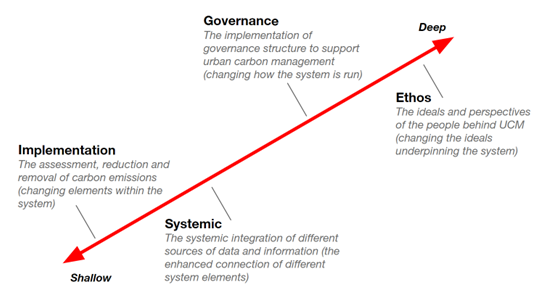

The task of urban carbon management is deeply complex and involves a range of different tools and approaches to deal with the technical, political and social challenges it contains. By using the systems engineering concept of leverage points we can see that the tools contained within the project’s UP Skilling phase collectively cover a range of levels of system intervention
By Will Brown – University of Cambridge
Cities across the globe are actively working towards reducing their carbon footprints, many with plans to be carbon neutral by 2050, or in some cases, by 2030. To support this, UP2030 contains a suite of tools and technical partners who are working with 11 partner cities on their journey towards carbon neutrality. Key to pursuing carbon neutrality is the process of ‘carbon accounting’.
Carbon accounting is the evaluation and monitoring of carbon emissions within the city – often done using the GPC framework - to record and track their carbon emissions. Carbon accounting is an essential step towards effectively reducing emissions. However, the act of reducing or removing emissions, an activity known as ‘carbon management’, is far more complex.
As a contribution to the conference of Transdisciplinary Engineering (TE2024) hosted in London this summer, I presented on the challenges that can limit effective carbon management across a city – what we call “urban carbon management” (UCM). UCM is not consistently defined in scientific literature. Our working definition is that UCM is:
“The governance and systemic integration of the planning, design and operation of all activities relating to the assessment, reduction and removal of carbon emissions produced within, and through the consumption patterns of a city or urban area”.
Whilst carbon accounting is a predominately technical undertaking, the task of managing (i.e. reducing and removing) a city’s emissions is one which covers not only the technical realm, but also the political and the social. The task of UCM therefore interlinks multiple areas of activity.
A way to connect these different activities is to conceive of them via ‘leverage points’. This concept, developed by Donella Meadows during the 1990s, centres upon places within complex systems - a complex system such as a city - where a small shift in one thing can produce big changes in everything.
What Meadows calls ‘shallow’ leverage points - those which do not change the whole system as such, but rather the function of elements within it - have the smallest impact upon systemic change, whilst 'deep’ leverage points – those intended to target the values and perspectives underpinning the system - produce the largest changes.
Meadows positions 12 leverage points on a scale of complexity, with shallower leverage points considered to be relatively simpler to implement than those at the deeper end of the scale. However, we’ve adopted David J. Abson and others’ perspective, where leverage points are grouped: implementation, systemic, governance and ethos (see: diagram below); each of which correlate to a different form of complexity; technical, systemic, political and social. These four leverage points, and the complexities contained within, are beset by their own challenges and require unique, often specialist expertise to overcome them. Therefore, each are uniquely complex.
To enhance the system as a whole, as opposed to working towards specific elements, these challenges, and the approaches utilised to overcome them, need to be viewed holistically, as a whole system. The leverage point concept affords the ability to view the system, in this case urban carbon management, as an integrated whole.
We can map the UP2030 tools and approaches contained onto each leverage point.*

A diagram illustrating the four groups of UCM leverage point.
Implementation: The assessment, reduction and removal of carbon emissions
The first leverage point group revolves around the technical challenges of conducting tasks associated with the assessment, reduction and removal of carbon emissions within UCM. The tools contained within UP2030 predominately centre upon digital approaches to modelling and assessing carbon emissions within buildings. CIRCE’s Building information model (BIM) Module and Life Cycle Assessment, as well as GUNAM/METU’s AI-Powered Toolset for the Decarbonization of Building & Transport Solutions, both perform this function, with the latter also, as the name suggests, modelling transport emissions.
Water distribution systems are also considered via LNEC’s Reclaimed water quality model, and ETH and UCCRN offer means to assess city-wide emissions via the former’s approach to ‘Circular Urban Planning’ and the latter’s Simulation Toolkit.
Systemic: The systemic integration of different sources of data and information
The next leverage point group centres on the systemic integration of different sources of data and information. Here, data and information are systemically integrated through three rather different approaches. To begin, Maggioli’s MIRA Digital Platform, a digital twin, which enables city planners and officials to simulate different scenarios across a city by utilising one platform.
Complementing this digital approach to integrating different city elements, Buro Happold and the University of Cambridge are working towards combatting siloisation within the urban realm. This is carried out by the former using their Climate Proofing Methodology to align climate mitigation and adaptation strategies within city authorities, and the latter conducting Urban Carbon Emission Data Flow Mapping to assess the flow of emission data by city authorities during the decision-making process for carbon budgeting - ultimately to understand who has access to this important data and who doesn’t, but should.
Governance: The implementation of governance structure to support urban carbon management
An important part of UP2030 revolves around cities making informed decisions through inclusive participation “so that real needs of communities are reflected in the city-specific visions, and co-designed interventions maximise delivery of co-benefits", a commitment which questions not only how to make better decisions, but importantly, who should have a hand in making them. A range of tools and approaches are included to expand the remit of city decision making.
Mapping for Change’s Community Maps is online interactive mapping platform promotes collaboration, community engagement, and informed decision-making, through harnessing the power of collective knowledge and contributions by leveraging crowdsourced data from the city.
LINKS’ Equal Services and Facilities Assessment tool helps authorities identify governance tools and processes to empower diverse social groups and increase bottom-up citizen engaged approaches. TU Delft also provide a means of supporting public participation and citizen engagement through their Citizen Voice digital spatial survey tool, which gathers both quantitative and qualitative data to understand citizens’ lived experiences and subjective experiences within a city.
VUB/CERTH’s Neutrality Story Maps, enables the sharing of experiences, issues, concerns, hopes and needs regarding climate and sustainability, and Design Clips have also developed the Urban Design Manual for Child and Youth Friendly Cities which integrates existing public participation frameworks with tailored activities specifically designed for children and youth.
Ethos: The ideals and perspectives of the people behind UCM
The final leverage point group concerns the ‘ethos’, the ideals and perspectives of the people behind UCM. Within UP2030 project, this takes the form of informing and, in a sense, educating decision makers - an important function given UP2030’s stated aim of supporting local authorities to “put neutrality on the map of their communities in day-to-day actions and strategic decisions”.
UCCRN’s Urban Design Climate Workshop, developed to engage different typologies of city actors in ‘co-created climate resilient design’ processes and ISOCARP’s Trainings for Capacity Building - designed to address organizational gaps in knowledge and skills related to urban planning and sustainability, whilst enabling participants to carry out future-proof sustainable urban planning – are geared towards supporting the embedding of neutrality in decision-making.
ISOCARP also have their Storytelling for Participatory Exchange approach which, rather than being explicitly designed to train decision-makers, facilitates co-exchange of knowledge, ideas, experiences, and obstacles among stakeholders through storytelling. According to the developers, this method “encourages individuals to communicate affectively rather than cognitively, reducing conflict and fostering productive, intersectional co-learning".
This theme of knowledge co-creation, an approach which is relatable to the above section’s emphasis on co-development and citizen participation, is further bolstered by the UP2030 Learning and Action Alliances developed and coordinated by ICATALIST.
Conclusion
The concept of leverage points is particularly useful to use when thinking holistically about any complex system like UP2030, which has 45 partners from 14 different nations. This review has demonstrated that across the tools and approaches involved within UP2030, each of the four UCM leverage points are well represented. The above tools and approaches have been designed to address unique challenges, yet by combining them, as is being demonstrated through UP2030, larger, more complex challenges like urban carbon management, or designing and building more equitable cities, can be overcome.
*For this we used UP2030 deliverables 3.4, 3.6 and 3.8 - the three most recent deliverables linked to the project’s 'UP-Skilling' phase:
D3.4: Bundle of digital twin tools for net zero decision-making 1
D3.6: Digital planning and design tools for climate neutral cities 1
D3.8: Tools and approaches for promoting inclusive participation and spatial justice 1


